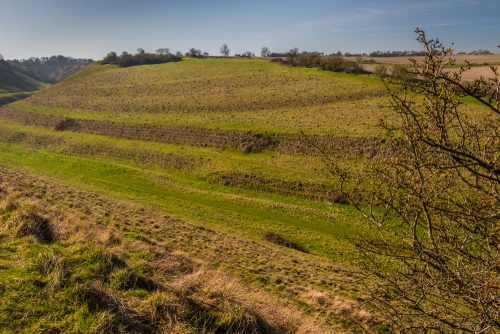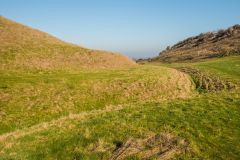
The Coombes is a steep-sided dry valley of chalk grassland on the edge of Hinton Parva village, a few miles east of Swindon. This botanically rich area is a Site of Special Scientific Interest (SSSI) in the care of the National Trust. It is covered with colourful wildflowers in summer.
The valley was formed from chalk deposited from the ocean that covered this area over 30 million years ago. It runs roughly north-south and is set into the southern flank of the Marlborough Downs.
Not only is The Coombes an important grassland habitat, but it also preserves a large area of medieval strip lynchets cut into the western flank of the valley side.

Medieval Lynchets
Strip lynchets evolved during the early medieval period as a way of bringing poor agricultural areas on steep hillsides into cultivation. The passage of ploughs over time created a similar effect to ridge and furrow on the valley floor. Repeated passage of the plough blade turned over the earth on one side, creating a broad terrace.
The lynchets are very clear on the slope of the hill, particularly when the sun is low in the sky and passes over the terraces at a low angle. You can walk along the lynchets but the best place to see them is to take the bridleway that runs along the top of the valley on the east side. You can look across the valley to the west slope and see the outline of the medieval field system very clearly.
The sloping sides of the valley have thin soil (unlike the valley floor) and thus support only varieties that thrive in those conditions, such as the devils-bit scabious, green-winged orchid, fragrant orchid and the clustered bellflower.
In the north-west corner of The Coombes is a traditional hay meadow, managed by the National Trust and separated from the main area of the valley by a spring-fed stream.
Hay meadows are not grazed; this allows grasses and wildflowers to set seed. The meadow can then be cut in late summer and used the combination of grass and flowers used as animal feed. This area is dotted with yellow cowslips in May.

Beside the stream is an area of pollarded willow trees and hedgerows emphasise the separation of the two main areas of the valley.
The rich chalkland supports a large butterfly population. Up to 23 different species have been found. The chalk soil also supports some rare plants usually not found elsewhere in the area, suggesting that The Coombes has a long history as a managed landscape.
There is a public bridleway running along the eastern boundary of the valley, but you can also walk down the centre of the valley and up a steep trail to the east side where The Coombes borders a traditional chalkland farmer's field.
During our visit, we saw people wandering everywhere across the valley floor and sides, so it clearly is a place where you are free to explore and enjoy without having to stick to clearly defined trails. On the eastern side of the valley is a bench where you can sit and soak up the wonderful views.
The Coombes is a delightful countryside area. The combination of the medieval field system and the traditionally-managed hay meadow makes it a fascinating place to explore.

Visiting The Coombes
Getting there is very easy. There are no signs on the road through Hinton Parva, which makes things awkward. We drove through the village twice before we realised that we had to turn into an unmarked drive immediately beside the village hall, near the village telephone box.
This leads to a free parking area behind the hall. At the back of the parking area, a gate leads into The Coombes. There is a National Trust information panel at the site entrance with a map of the valley and details on what to look for.
The Coombes is not large but if you want to walk to the far end and back (one mile) as well as take the time to explore the strip lynchets then I would suggest allowing an hour.
About The Coombes, Hinton Parva
Address: Bodyhorse Hill,
Hinton Parva,
Wiltshire,
England, SN4 0DH
Attraction Type: Countryside
Location: There is free parking behind the village hall in Hinton Parva and a The Coombes is accessed through a gate at the back of the parking area.
Website: The Coombes, Hinton Parva
Email: wiltshire.countryside@nationaltrust.org.uk
National Trust
Location
map
OS: SU228829
Photo Credit: David Ross and Britain Express
HERITAGE
 We've 'tagged' this attraction information to help you find related historic attractions and learn more about major time periods mentioned.
We've 'tagged' this attraction information to help you find related historic attractions and learn more about major time periods mentioned.
Find other attractions tagged with:
NEARBY HISTORIC ATTRACTIONS
Heritage Rated from 1- 5 (low to exceptional) on historic interest
Hinton Parva, St Swithun's Church - 0.3 miles (Historic Church) ![]()
Ashbury, St Mary Church - 2.6 miles (Historic Church) ![]()
Ashdown House - 3.4 miles (Historic House) ![]()
Wayland's Smithy - 3.6 miles (Prehistoric Site) ![]()
Shrivenham, St Andrew's Church - 3.8 miles (Historic Church) ![]()
Baydon, St Nicholas Church - 4.5 miles (Historic Church) ![]()
Aldbourne, St Michael's - 4.9 miles (Historic Church) ![]()
Uffington White Horse - 5.1 miles (Prehistoric Site) ![]()
Nearest Holiday Cottages to The Coombes, Hinton Parva:
Marlborough, Wiltshire
Sleeps: 6
Stay from: £669 - 2657
More self catering near The Coombes, Hinton Parva










